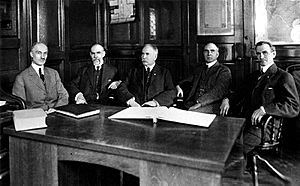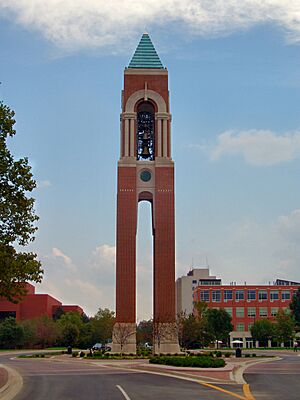History of Ball State University facts for kids
The History of Ball State University tells the story of how this well-known school in Muncie, Indiana, came to be. It started as a private school almost 20 years before it became a public university. Different schools operated on the same land before 1918, but they weren't public and didn't have "Ball" in their name.
Contents
Timeline of Ball State University
Quick facts for kids Early Schools (now BSU's Administration Building) |
||||
|---|---|---|---|---|
| Eastern Indiana Normal School | Started | 1899 | Type | private |
| Palmer University | Took over | 1902 | ||
| Indiana Normal School and College of Applied Science | Took over | 1905 | ||
| Closed | 1907 to 1912 | |||
| Muncie Normal Institute | Took over | 1912 | ||
| Muncie National Institute | Renamed | 1913 | ||
| Closed | 1917 to 1918 | |||
| Modern Era | ||||
| Eastern Division of Indiana State Normal School | Started | 1918 | Type | public |
| Ball Teachers College, Eastern Division, Indiana State Normal School | Renamed | 1922 | ||
| Ball State Teachers College | Renamed | 1929 | Managed by | Indiana State Teachers College Board |
| Ball State College | Became Independent | 1961 | Managed by | Ball State's Board of Trustees |
| Ball State University | Renamed | 1965 | ||
The Early Years (Before the Ball Family)
The land where Ball State University stands today started as a private school in 1899. It was called the Eastern Indiana Normal School. Its main goal was to train teachers. The whole school, including classrooms and the library, was in one building. This building is now known as the Ball State Administration Building.
This first school had up to 256 students. It cost only $10 for a year of classes. The school closed in 1901 because it ran out of money.
A year later, in 1902, the school reopened as Palmer University. A retired banker named Francis Palmer gave the school $100,000. This money helped it stay open for three years.
Between 1905 and 1907, the school changed its name again. It became the Indiana Normal College. It had two parts: one for training teachers and another for applied sciences. About 200 students attended the school. However, fewer students enrolled, and money became tight. The school closed again at the end of the 1906–1907 school year.
From 1907 to 1912, the campus was empty. A local farming family paid the property taxes. They used the land for grazing sheep and cattle. They also used the Administration Building for storage.
In 1912, a group of local business people reopened the school. They called it the Indiana Normal Institute. To pay for new materials and fix up the old building, the school took out a loan. Even though it had its largest number of students (806), the school couldn't pay back the loan. It closed once more in June 1917.
The Ball Brothers Step In
On July 25, 1917, a group of local business owners stepped in. These were the Ball Brothers, who founded the Ball Corporation. They bought the Indiana Normal Institute for $35,100. They bought the Administration building and the land around it. This land is now bordered by University Avenue, McKinley Avenue, Riverside Avenue, and Tillotson Avenue. They kept one part of the land as a wildlife preserve called Christy Woods.
The Ball Brothers were very generous. They decided to give the school directly to the state of Indiana. They worked with the governor, James Putnam Goodrich. In early 1918, state lawmakers accepted this generous gift. The state gave control of the Muncie campus to the leaders of the Indiana State Normal School in Terre Haute, Indiana.
On June 17, 1918, the first students enrolled at the Indiana State Normal School, Eastern Division. There were 235 students at first. The school's main goal was to train teachers. These teachers would work in public schools in nearby cities like Muncie, Anderson, and Fort Wayne.
The school slowly grew over the next few years. More than 400 students enrolled. The Ball family continued to help the school. They gave money to build the Ball Gymnasium.
People started calling the school "Ball State" because of the Ball family's help. It was a shorter, easier name. In 1922, the state officially renamed the school the Ball Teachers College. This was to honor the Ball family's ongoing support. At this time, the school also got its own local board of trustees.
In 1924, Benjamin J. Burris became the first president of the state-funded college. The Ball Brothers kept giving money to the university. They helped pay for the Science Hall (now Burkhart Building) in 1924. They also helped add to the Ball Gymnasium in 1925. By the 1925–1926 school year, Ball State had 991 students.
Ball State Teachers College
In 1929, the state of Indiana officially separated the Muncie campus from the Terre Haute campus. However, the Ball State campus was still managed by the Indiana State Teachers College Board. At this time, the school was renamed Ball State Teachers College. The next year, enrollment grew to 1,118 students.
In 1935, the school added the Arts Building. This building was for art, music, and dance classes. Today, it holds the Ball State Art Museum and geology classes. Enrollment that year reached 1,151 students.
To celebrate the many gifts from the Ball family, a special statue was made. The Muncie Chamber of Commerce asked sculptor Daniel Chester French to create it. His statue, called Beneficence, still stands today. It is a bronze figure that honors the Ball Brothers' gifts.
The school grew steadily until the 1940s. When World War II started, many students joined the military. By 1944, enrollment dropped to 550 students. This was the lowest since the 1910s. During the war, the U.S. military built barracks on campus. These were used for training and other purposes.
In 1945, John R. Emens became the school's fifth president. In 1946, Ball State bought the Christy Woods preserve.
After World War II, many veterans came to Ball State. They used the G.I. Bill to pay for their education. The school grew much faster. The military barracks were used as dorms for the new students.
By 1950, the school had 3,144 students. That same year, radio station WBST-FM began broadcasting from the Administration Building.
In 1961, Ball State became fully independent from Indiana State. A new board of trustees was created just for Ball State. Also in 1961, the school's name changed to Ball State College.
Ball State University
In 1965, the school's name changed again to Ball State University. This was because the school had grown a lot. It was no longer just a school for training teachers. Enrollment reached 10,066 students.
After becoming a "University," Ball State started to grow academically. In 1965, the College of Architecture and Planning was created. This college offered the only public architecture degrees in Indiana. More programs were added, and more teachers were hired.
Ball State has continued to grow almost constantly. Today, enrollment is the highest it has ever been. New dorms like Park Hall (2007) and Kinghorn Hall (2010) have been built. The university now offers bachelor's degrees in many different areas. There are over fifty individual programs. This is a big increase from the five programs it first offered. In 2021, Ball State had about 22,443 students, including both undergraduate and graduate students.
Past Presidents
- William Wood Parsons (1918–1921)
- Linnaeus Neal Hines (1921–1924)
- Benjamin J. Burris (1924–1927)
- Lemuel Arthur Pittenger (1927–1942)
- Winfred Ethestal Wagoner (1943–1945)*
- John Richard Emens (1945–1968)
- John J. Pruis (1968–1978)
- Richard W. Burkhardt (1978–1979)*
- Jerry M. Anderson (1979–1981)
- Robert P. Bell (1981–1984)
- John E. Worthen (1984–2000)
- Blaine A. Brownell (2000–2004)
- Beverley J. Pitts (2004)*
- Jo Ann M. Gora (2004–2014)
- Paul W. Ferguson (2014–2016)
- Terry S. King (2016–2017)*
- Geoffrey Mearns (2017–present)
* Interim presidency (meaning they served temporarily)
See also



